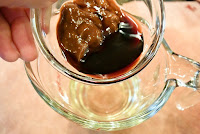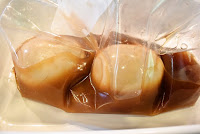A popular topping for ramen noodles! These eggs are also tasty on their own, in addition to working well as a topping for other types of noodles or steamed rice and as part of a salad (one of key components or as dressing). The recipe below involves slow flavoring in the fridge, where eggs are ready starting on Day 2 and lasting at least to Day 6.
83 calories (1 egg); 6.6 g protein; 5.3 g fat; 1.4g carbohydrate; 1.2 g net carbs; 115 mg sodium (with 50% reduced-sodium soy sauce and shoyukoji made of 50% reduced-sodium soy sauce); 214 mg cholesterol; 0.2 g fiber; 74 mg potassium
<Ingredients>
4 eggs
For marinade
1 1/2 tbsp shoyukoji soy sauce rice malt
1/2 tbsp soy sauce
1 tsp mirin
1/4 tsp kurozu brown rice vinegar (or regular rice vinegar)
4 tbsp dashi
<Directions>
1.
Bring to boil plenty of water (enough to cover eggs).
2.
Gently place eggs (bamboo basket is used in photo; if not using a strainer, put individual eggs with a spoon or ladle into boiling water).
Boil for 6-7 minutes (closer to 6 minutes if eggs have been kept near room temperature; closer to 7 minutes if eggs have just come from the fridge).
Turn eggs often for the first 2-3 minutes to center yolk.
3.
Meanwhile, mix all ingredients for marinade, microwave for 30 seconds (or bring to boil in small pot), and let cool.
4.
Immediately transfer to ice water to cool.
5.
When cool, shell, and place in plastic bag.
Pour marinade, remove air inside bag as much as possible, close bag, and refrigerate.
(Ready from the next day.)
(Day 4)
<Notes>
(Last updated: May 3, 2016)
83 calories (1 egg); 6.6 g protein; 5.3 g fat; 1.4g carbohydrate; 1.2 g net carbs; 115 mg sodium (with 50% reduced-sodium soy sauce and shoyukoji made of 50% reduced-sodium soy sauce); 214 mg cholesterol; 0.2 g fiber; 74 mg potassium
<Ingredients>
For marinade
1 1/2 tbsp shoyukoji soy sauce rice malt
1/2 tbsp soy sauce
1 tsp mirin
1/4 tsp kurozu brown rice vinegar (or regular rice vinegar)
4 tbsp dashi
<Directions>
1.
Bring to boil plenty of water (enough to cover eggs).
2.
Gently place eggs (bamboo basket is used in photo; if not using a strainer, put individual eggs with a spoon or ladle into boiling water).
Boil for 6-7 minutes (closer to 6 minutes if eggs have been kept near room temperature; closer to 7 minutes if eggs have just come from the fridge).
Turn eggs often for the first 2-3 minutes to center yolk.
3.
Meanwhile, mix all ingredients for marinade, microwave for 30 seconds (or bring to boil in small pot), and let cool.
4.
Immediately transfer to ice water to cool.
5.
When cool, shell, and place in plastic bag.
Pour marinade, remove air inside bag as much as possible, close bag, and refrigerate.
(Ready from the next day.)
(Day 4)
<Notes>
- Nitamago [lit. simmered eggs] is also called ajitsuke tamago [lit. flavored eggs] or aji-tama (shortened form of ajitsuke tamago).
- If shell breakage is a concern (especially with eggs just brought out of the fridge), add a small amount of salt or vinegar to boiling water o help solidifying egg whites faster.
- Super fresh eggs tend have a bumpy surface when shelled. If you have only very fresh eggs, first bringing them to room temperature before boiling is said to help minimize craters after boiling.
- The above nutrition figures are based on one-third of marinade being absorbed by eggs, which is a very conservative calculation. The sodium intake figure is calculated by subtracting marinade's remaining sodium content, which is measured with a sodium checker.
- For variations, try curry flavor (add 1-2 tsp curry powder to marinade) or star anise flavor (add one hakkaku star anise to marinade; remove it after 2-3 days). Replacing part of soy sauce with oyster sauce also gives a nice Chinese twist.
(Last updated: May 3, 2016)











No comments:
Post a Comment